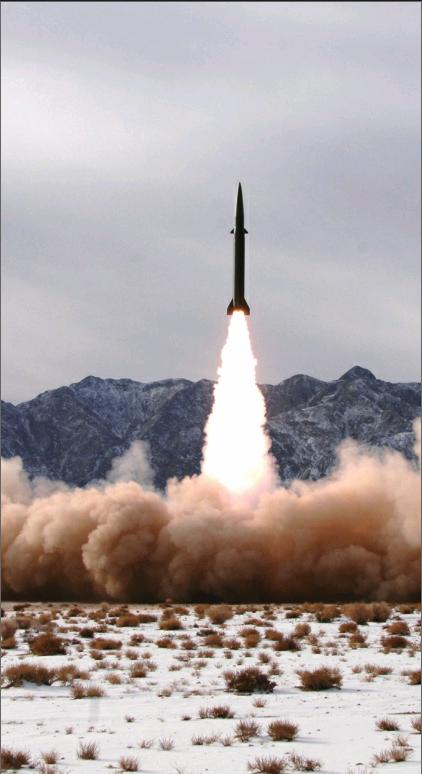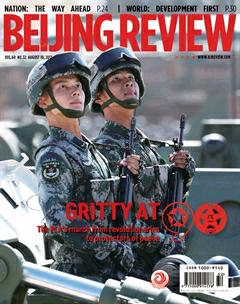FOLLOWING THE CALL OF SERVICE
By+Lu+Yan



Jing Haipeng is a household name in China. In 2016, the then 50-year-old became the first Chinese to go into space for the third time after he completed a manned space mission with his fellow astronaut Chen Dong. Jings first space odyssey was in 2008 with the second one coming four years later.
The success of the missions stemmed from the hardship Jing had learned to shoulder in the course of his career with the Chinese Peoples Liberation Army (PLA). He has been a soldier for 32 years, 12 years of it as a fighter pilot and the rest as an astronaut, during which he underwent rigorous training and unimaginably tough tests.
Even so, he wasnt picked as a candidate for the Shenzhou 5 mission, Chinas first manned spaceflight in 2003; in 2005, he was selected as a backup astronaut for Shenzhou 6. But instead of being discouraged, he trained harder and constantly sought advice from his predecessors.
“If I am not selected this time, Ill try harder when the next opportunity arises,”Jing wrote in an article in July 2017. “For me, the process and participation are more important than the result.”
At a press conference last year, a reporter asked Jing why he chose to go into space for a third time, despite the dangers involved. His answer was that it was an honorable mission for an astronaut. “Although there are risks and even dangers, I love my job and am willing to give my all to it,” he said.
On July 28 this year, four days ahead of Army Day, Jing was awarded the Order of Bayi, the top honor established this year to be bestowed by the Central Military Commission (CMC) every five years on those who have made outstanding contributions to safeguarding national sovereignty, security and development interests, and advanced the modernization of national defense and the armed forces.
There are millions more dedicated personnel like Jing who embody the tenacious spirit of the 90-year-old PLA. As President Xi Jinping said in his address at a grand gathering in Beijing on August 1 to celebrate the 90th founding anniversary of the PLA, the bravery and persistence of the forces have helped them win the Partys trust, peoples compliments, and respect from the world.
Nine decades devotion
The PLA has come a long way since its birth from the Nanchang Uprising, an armed resistance led by the Communist Party of China (CPC) to the Kuomintang on August 1, 1927 in Nanchang, Jiangxi Province. The armed resistance led to the creation of the revolutionary army. Subsequently, August 1 is celebrated as Army Day.
Today, the PLA commands more than 2 million service personnel, compared to the 5.5 million when the Peoples Republic of China (PRC) was founded in 1949. It has transformed, as Xi said, from a “millet-plusrifles” single-service force that had only the most basic supplies and equipment into one with fully-fledged services.
Xi, also General Secretary of the CPC Central Committee and Chairman of the CMC, told the gathering that the PLA has basically completed mechanization and is moving rapidly toward becoming a strong, informationized armed force.
“Behind the glorious victories are also the ideals and beliefs, as well as the reform determination of the armed forces,” Xi said.“Only by continuous reform and innovation can the peoples army gain development vitality and put itself in an impregnable position.”
To combat rigidity and stagnation, the PLA has carried out bold reforms and adopted innovation as the CPC put forward new ideas and requirements for national defense and military building in the past five years. A series of major structural reforms have been made, including the establishment of the PLA Army General Command, the PLA Rocket Force and the PLA Strategic Support Force.
The original four general departments of the PLA—the Headquarters of the General Staff, the General Political Department, the General Logistics Department and the General Armament Department—have been reorganized into 15 agencies of the CMC, and five theater commands have replaced the earlier seven military area commands. The CMC has taken charge of the overall military administration, while the theater commands focus on operations and different services for troop development.
Xi said fundamental changes have taken place in the governance of the military. With combat effectiveness as the “sole and fundamental” standard, the PLA remains resolved to safeguard the countrys territorial sovereignty and maritime rights and interests, he added.
“It was inspiring to me, as a foreigner, to note President Xis profound patriotism and clear vision,” Clifford A. Kiracofe, former senior professional staff member of the U.S. Senate Committee on Foreign Relations, told Beijing Review. “His comments on protecting the sovereign independence of China go to the heart of the geopolitical matter. Xi combines a heartfelt commitment to the human factor embodied by the men and women in military service with a deep and scientific appreciation for the necessity of modernization.”
Xi said the Party is a “fundamental guarantee” for the army to maintain its cohesion, creativity and combat capabilities, reaffirming the CPCs absolute leadership over the PLA.
His sentiment echoed what late Chinese leader Mao Zedong had said at the Sixth Plenary Session of the Sixth CPC Central Committee on November 6, 1938:“Our principle is the Party commands the gun, and the gun must never be allowed to command the Party.”
The PLA will continue with its reforms, including downsizing its troops by 300,000 by the end of this year to phase out outdated armaments and optimize resources. This is a big step toward the goal of becoming a world-class army.
The PLA has also intensified the fight against corruption. Military personnel who violated the law and discipline code are held accountable. More than 100 senior officers have been investigated and punished since 2012, including Guo Boxiong and Xu Caihou, former vice chairmen of the CMC.
As part of its anti-corruption efforts, the CMC has established the discipline inspection commission, politics and law commission and audit office, and stationed discipline inspectors in its subordinate departments and theater commands.
Symbol of reform
Qu Yanping, a 52-year-old retiree, almost cried as she watched the military parade at the Zhurihe military training base in north Chinas Inner Mongolia Autonomous Region on July 30 on TV.
It was the first time that Army Day was commemorated with a military parade since the founding of the PRC. Over 12,000 soldiers and a broad array of weapons and military equipment were reviewed by Xi in 45 formations.
“Im so proud of the soldiers and my country,” Qu said.
The parade epitomized Chinas ongoing military reform, which stresses quality over quantity and science and technology-intensive development over one that is manpower-intensive. The troops are becoming increasingly flexible and multi-functional.
At the founding ceremony of the PRC on October 1, 1949, there were only 17 planes on display and most of the military equipment, seized in battles, was made abroad.
Since then, Chinas military equipment has been upgraded step by step. At the National Day parade in 1984, made-in-China equipment dominated. At the parade celebrating the PRCs 50th anniversary, 95 percent of the displayed equipment was made domestically. At the parade commemorating the 70th anniversary of the Victory of the Chinese Peoples War of Resistance Against Japanese Aggression and World Anti-Fascist War in 2015, all the equipment was made in China.
At the military parade before the 90th Army Day, more than 100 airplanes of various types as well as 600 sets of ground equipment were put on display, 40 percent of which were shown for the first time.
One of the most impressive displays was a trio of the latest J-20 stealth fighters, leading a formation of 15 fighter aircraft. The J-20, Chinas indigenous fourth-generation medium and long-range fighter jet, made its maiden flight in 2011 and was first publicly displayed at the 11th Airshow China in Zhuhai, Guangdong Province, in November 2016.
“The enlisting of Chinas fourth-generation fighter jets brings fundamental changes to the rules of the game in air battles,”Wang Mingzhi, a professor at the PLA Air Force Command College, told Xinhua News Agency. “It will also draw the curtain on transformation in the PLA Air Force.”
“Although the scale of the parade is not enormous, it is of great significance,” Wang Chuanbao, a professor at the Institute of Political Studies at the PLA National Defense University, wrote in an opinion piece published on China.com.cn.
Contrary to suggestions in some media reports, the parade was not a show of strength, but a reminder that China, as a staunch defender of peace, is determined to fight aggression and any attempt to split the nation. It was also an indication that the countrys modernization and revitalization process will not be allowed to be disturbed.
“This was a grand event after the deepening of military reform. It was not just a show, but an actual maneuver and practice, a demonstration of the PLAs ability to safeguard peace,” Wang Chuanbao said, adding that a strong military can effectively defend peace and prevent war.
“The PLA, undergoing reforms, will never surrender to outside threats. This is the most important signal the parade has sent,” he emphasized.
Apart from the military parade, many other events have been organized to cel-ebrate the PLAs 90th founding anniversary. Provinces organized theme-based activities for veterans; art exhibitions were opened and commemorative stamps issued. A film, The Founding of An Army, was released to mark the event.
Sun Hongyan, an army man from Jilin Public Security and Border Defense Corps in northeast China, watched director Andrew Laus film intently. “As an officer, from my personal experience I can see every soldiers love for the country and determination to serve the country,” he said. “Its the dedication and sense of responsibility of individual soldiers that build a strong army. We will continue to do our best to complete each assigned task, be it big or small.”

